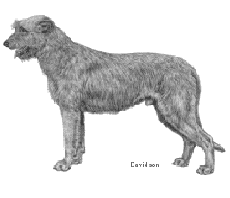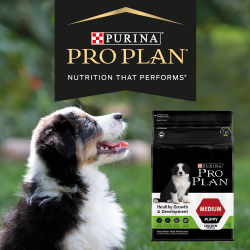Irish Wolfhound
General Information - Irish Wolfhound

Group:
Hound
Size:
extra large
Lifespan:
5-7 years
Exercise:
medium
Grooming:
very low
Trainability:
low
Watchdog ability:
medium
Protection ability:
low
Area of Origin:
Ireland
Date of Origin:
ancient times
Other Names:
none
Original Function:
Coursing wolves
and elk
History
The Irish Wolfhound, the largest of the sighthounds, traces its roots to antiquity in Ireland, where it was known as "Cu" (meaning hound or greyhound). These gentle giants were great hunters of elk, wild boar and wolves. They were considered royal dogs and were owned by the nobility; certainly the average peasant could not afford to feed such a large dog. Their numbers dwindled during the 1800's, but a Scottish officer, Captain Graham, undertook the restoration of the breed; he sought out the best specimens he could find and with judicious outcrossings to Deerhounds and Great Danes, he was able to save the breed from extinction. By the end of the 19th century, size and type were breeding true.
Temperament
The Irish Wolfhound is a sweet gentle breed that is truly loyal to their owners. They require firm training and are friendly by nature therefore not making good watchdogs. Irish Wolfhounds are friendly with other dogs and can be left alone with children. This breed requires two years before it reaches full maturity. Irish Wolfhounds have also been known to be somewhat clumsy.
Upkeep
The Irish Wolfhound enjoys a long walk and a chance to stretch its legs, so it needs daily exercise. At home it needs ample room to stretch out on a soft surface and should not be required to live in cramped quarters. It can develop calluses if allowed to lie on hard surfaces too often. Its coat needs to be brushed or combed once or twice weekly, plus occasional slight scissoring to neaten up straggly hairs. Dead hairs should be stripped twice a year.
Irish Wolfhound
A breed standard is the guideline which describes the ideal characteristics, temperament, and appearance of a breed and ensures that the breed is fit for function with soundness essential. Breeders and judges should at all times be careful to avoid obvious conditions and exaggerations, as well as being mindful of features which could be detrimental in any way to the health, welfare or soundness of this breed.
Breed Standard - Irish Wolfhound
 General Appearance:
General Appearance: The Irish Wolfhound should not be quite so heavy or massive as the Great Dane, but more so than the Deerhound, which in general type he should otherwise resemble. Of great size and commanding appearance, very muscular, strongly though gracefully built, movement easy and active, head and neck carried high; the tail carried with an upward sweep with a slight curve towards the extremity.
Head and Skull: Long, the frontal bones or the forehead very slightly raised and very little indentation between the eyes. Skull not too broad. Muzzle long and moderately pointed.
Eyes: Dark.
Ears: Small and Greyhound-like in carriage.
Neck: Rather long, very strong and muscular, well arched, without dewlap or loose skin about the throat.
Forequarters: Shoulders muscular, giving breadth of chest, set sloping. Elbows well under, turned neither inwards nor outwards. Leg and forearm muscular and the whole leg strong and quite straight.
Body: Chest very deep. Breast wide. Back rather long than short. Loins arched. Belly well drawn up.
Hindquarters: Muscular thighs and second thighs; long and strong as in the Greyhound, and hocks well let down and turning neither in nor out.
Feet: Moderately large and round, turned neither inwards nor outwards. Toes well arched and closed. Nails very strong and curved.
Tail: Long and slightly curved, of moderate thickness and well covered with hair.
Coat: Rough and hardy on body, legs and head; especially wiry and long over eyes and under jaw.
Colour: The recognised colours are grey, brindle, red, black, pure white, fawn, or any colour that appears in the Deerhound.
Weight and Size: The minimum height and weight of dogs should be 79 cm (31 in) and 54.5 kg (120 lb); of bitches, 71 cm (28 in) and 40.9 kg (90 lb). Anything below this should be heavily penalised. Great size, including height at shoulder and proportionate length of body, is the desideratum to be aimed at, and it is desired to firmly establish a breed that shall average from 81 - 86 cm (32 - 34 in) in dogs, showing the requisite power, activity, courage and symmetry.
Faults: Too light or heavy a head, too highly arched frontal bone; large ears; ears hanging flat to the face; short neck; full dewlap; too narrow or too broad a chest; sunken, hollow or quite straight back, bent forelegs; overbent fetlocks; twisted feet; spreading toes; too curly a tail; weak hindquarters and a general want of muscle; too short in body; pink or liver:coloured eyelids; lips and nose any colour other than black; very light eyes.
Note: Male animals should have two apparently normal testicles fully descended into the scrotum.
DNZ No 476
Copyright Dogs New Zealand
01 Jan 2002
Any departure from the foregoing points should be considered a fault and the seriousness with which the fault should be regarded should be in exact proportion to its degree and its effect upon the health and welfare of the dog and on the dog’s ability to perform its traditional work.




